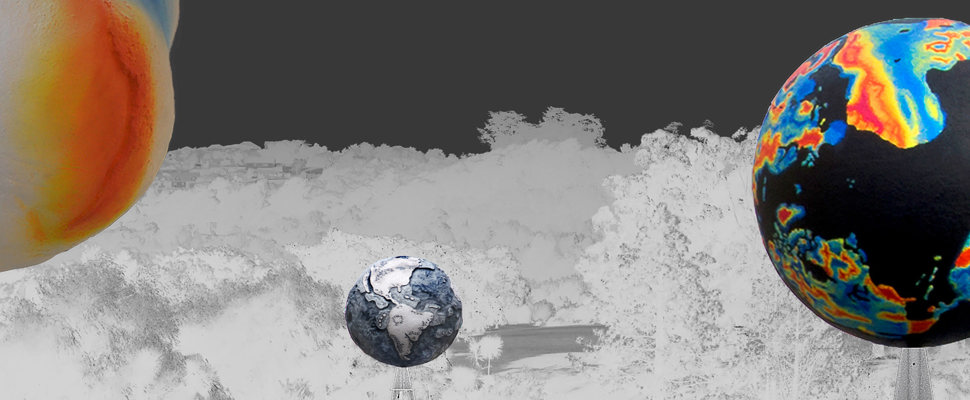
Other worlds: interview with artist Ruth Watson
Sculpture on display at Auckland Botanic Gardens: 2 Sep – 14 Oct
Artist biography
Born and raised in Canterbury, Ruth Watson spent her early years near West Melton. She studied at the Ilam School of Fine Arts in Christchurch, first focusing on painting before moving to a more interdisciplinary practice including photography, video, and sculpture. An interest in maps and its representational methods has been a common thread in her diverse body of work.
In 2004, Watson collaborated with the ANU Research School of Astronomy and Astrophysics to create the largest map of the universe at that time. She is also the graduate of a science-based course in Antarctica, which inspired a series of artworks across several exhibitions. She completed her MFA at the Sydney College of the Arts, and has a PhD from the Australian National University, where her map of the universe was presented as her final artwork.
Currently based in Tāmaki Makaurau Auckland, Watson's journey has taken her from Berlin to Australia, and back to New Zealand. She has represented both Australia and New Zealand on several occasions, and has exhibited in the 9th Sydney Biennale, at the Frankfurter Kunstverein, the Stedelijk Museum in Amsterdam, the Queensland Art Gallery/Gallery of Modern Art in Brisbane, and the Asia Society Museum and Gallery in New York City. She is currently exhibiting with Sumer Gallery in Tāmaki Makaurau Auckland and is a Senior Lecturer at Te Waka Tūhura Elam School of Fine Arts, University of Auckland.
Beginnings of ‘Other worlds’
In 2018, Ruth Watson was commissioned by the Wellington Sculpture Trust to create a large-scale work to occupy four permanent plinths, that border the Te Papa Tongarewa forecourt, Wellington. Watson would create a work that featured four 2-meter diameter globes.
“I was looking for globes that would be familiar in the sense that someone would look at them and know it was a representation of our Earth, but also different enough to indicate that it wasn’t the world as we usually see it, perhaps a bit odd or unfamiliar,” she says.
Watson wanted to use existing models of the world, and of Mars, as a form of exploring ideas that have been overlooked or are askance with ordinary views.
“One of the first things I thought of was our regular notion of the globe as a perfect sphere, when in fact, our planet is a bit more grapefruit-like, flattened at both poles. So, I deliberately went looking for existing models that disrupted the shape and perhaps the surface of the Earth.”
Research for ‘Other worlds’
The first model that Watson developed was derived from data from a European Space Agency GIF showing the Earth’s gravity fields that she turned into a 3D model. This model presented a very non-spherical globe.
“Another map that came to mind was one from the 17th Century, from a religious tract about the world’s creation, showing their idea of the world before God created the oceans. That map has a wonderfully crinkled edge to the world, almost like a walnut shell. So those two – with their differing degrees of ‘deformation’ – formed the first chosen models.”
Watson next drew on an early 20th Century globe of Mars, a speculative view based on the belief that Mars was home to a superior civilisation. She was also attracted to it as it featured overlapping canals that produced a shape a bit like Aotearoa New Zealand, giving it a sense of the familiar.
The final globe represents carbon sequestration data, by showing the different parts of the planet that absorb carbon dioxide. In the reference article, the oceans were devoid of data and rendered in grey but here they are represented in black.
Please visit
Watson invites you to experience these large-scale globes in the expansive setting of the Auckland Botanic Gardens. These four worlds are at the same time familiar and unfamiliar. They encourage us to be open to think differently about global perspectives in relation to our climate, new technology, mythologies and more.
Other worlds is exhibited by Auckland Council Public Art in conjunction with the Auckland Botanic Gardens for the World Green Infrastructure Congress 3-5 Sep 2024.
Public Programme
Otherworldly worlds: a free, drop-in drawing/collage workshop with artist Ruth Watson.
Mon 7 Oct, 1pm – 3pm. All ages.
Join Ruth in the Visitor’s Centre to make an image of a your own ‘world’. You can participate for as long as you like. Ruth will guide you with drawing and collage.
Learn about Public Art in Auckland
Visit the Auckland Public Art website: www.aucklandpublicart.com/